Facebook Groups Vs Facebook Pages
Are you confused whether to create a Facebook Page or Group? In brief, Facebook Pages are conceived for businesses and organizations looking to communicate with their audience, whereas Facebook Groups should be used to centralize people with common interest and provide them with a platform to interact together such as an alumni group.
Feature Comparison
Below is a straightforward feature comparison which will help you determine the most adequate Facebook presence.
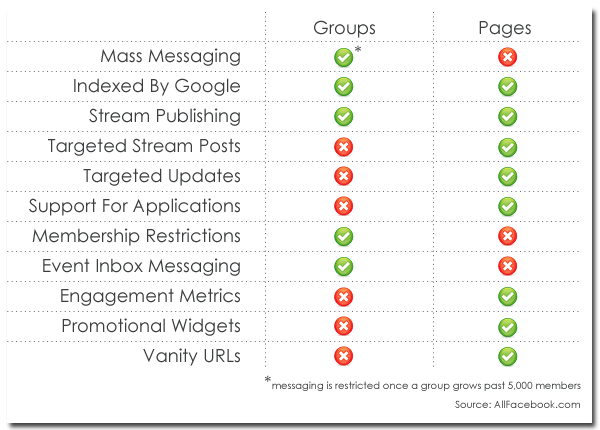
Mass Messaging
Facebook Groups: Enable you to send messages directly to members’ Facebook Inboxes, as long as the number of group members does not exceed 5,000.
Facebook Pages: Feature not available (see Targeted Updates instead).
Indexed By Search Engines
Facebook Groups: Are indexed by Search Engines.
Facebook Pages: Are indexed by Search Engines but they offer wider search engine optimization options when used in combination with the Static FBML application.
Stream Publishing
Facebook Groups: Enable publishing stories to members’ news feeds.
Facebook Pages: Enable publishing stories to likers’ news feeds.
Targeted Stream Posts
Facebook Groups: Feature unavailable.
Facebook Pages: Enable to target stream posts based on location and language.
Targeted Updates
Facebook Groups: Feature unavailable (see Mass Mailing instead)
Facebook Pages: Enable the Facebook Page to send updates. Updates show in fans’ inboxes but under a separate tab “Updates”, which is more efficient.
Applications Support
Facebook Groups: Feature unavailable.
Facebook Pages:
- Provide Administrators with great flexibility to customize Page.
- Enable Administrators to create custom Tabs within their Page.
- Enable Pages to host customized applications (See Sweepz Facebook Application to learn how you can brand and customize your own Facebook sweepstakes or contest).
Membership Restrictions
Facebook Groups:
1) Provide the possibility to limit access to the Groups, using three levels of restrictions:
- Open groups enable anybody to join.
- Closed groups appear in Facebook search results but group administrators must approve all members of the group.
- Secret groups are not visible in Facebook search results and are accessed by invite only.
Facebook Pages
1) Are always public and there is no option to make them private.
2) Provide the possibility to limit access by country, gender and age.
Event Inbox Messaging
Facebook Groups: Provide the possibility to send event invites to Group members, as long as the number of group members does not exceed 5,000.
Facebook Pages: Event information can be sent via the Page updates which limits visibility and reach. Therefore Facebook ads are more effective to promote the event.
Engagement Metrics
Facebook Groups: Feature unavailable.
Facebook Pages: Provides information about the Facebook Page likers’ demographics, and engagement level. (Number of Views, likes, comments etc.).
Promotional Widgets
Facebook Groups: Feature unavailable.
Facebook Pages: Administrators are provided with the Facebook Fanbox widget to help promote the Facebook Page.
Vanity URLs
Facebook Groups: Feature unavailable.
Facebook Pages: Help promote the Facebook Page using Vanity URLs (i.e: www.facebook.com/username) which are the unique URLs that redirect users to the Facebook Page.
Source: http://www.allfacebook.com/facebook-page-or-group-2010-07

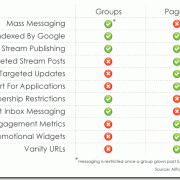
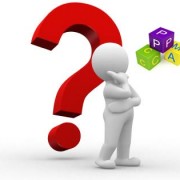
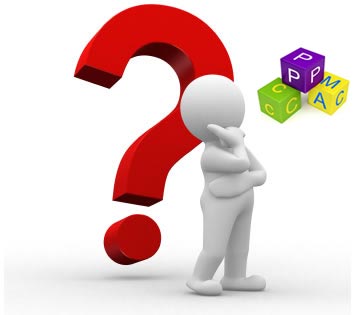 For most of us involved in
For most of us involved in 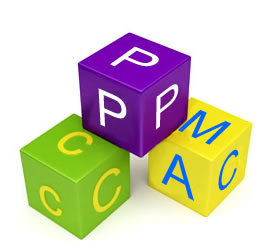 One of the very few problems of the CPC model is the possibility of running into click-frauds. A click-fraud occurs when an automated script attacks a website and generates hundreds of fake clicks on a banner, turning a successful campaign into a nightmare. Combating this fraudulent method is something that any publisher has to keep in mind before opting to use a CPC model.
One of the very few problems of the CPC model is the possibility of running into click-frauds. A click-fraud occurs when an automated script attacks a website and generates hundreds of fake clicks on a banner, turning a successful campaign into a nightmare. Combating this fraudulent method is something that any publisher has to keep in mind before opting to use a CPC model.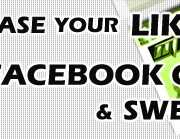

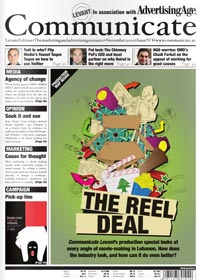 Love Letters to the Future, produced by Canada-based firm Xenophile Media, and whose digital strategy was developed by Beirut-based online agency Eastline Marketing, won two gongs at the 14th edition of the Webby Awards, established in 1996 to honor excellence on the Internet.
Love Letters to the Future, produced by Canada-based firm Xenophile Media, and whose digital strategy was developed by Beirut-based online agency Eastline Marketing, won two gongs at the 14th edition of the Webby Awards, established in 1996 to honor excellence on the Internet.